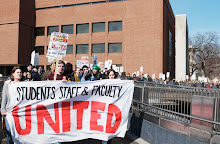This means that the university made an instructional profit on each student of $15,553 for a total of $2.6 billion. In other words, teaching undergrads is a highly profitable business, and these students actually subsidize everything else universities do.We don't have access to all the same types of data for UMN that Samuels did ... but we've got enough of it to approximate his analysis here. And what we're missing (e.g., figures on how much the state subsidizes each student) would tend to skew the figures that we can generate in ways that make things look better than they actually are.
By our calculations, roughly $288m of the $1.2b that the UMN system spends on payroll each year goes towards faculty and instructors who actually teach undergraduates. With roughly 33,000 undergraduates system-wide, that works out to a per-student instructional cost of $8,667.72 for one year. Annual in-state tuition and fees, however, are $12,288. That's a profit of more than $3,600 per student before we factor in whatever portion of the state appropriation is actually spent on undergraduate education.
To be sure, some of that excess helps to fund facilities and services that are vital to undergraduate education. Libraries, computer labs, and classroom maintenance (to name just three) aren't free, and there are thousands of front-line non-instructional staff without whom undergraduate instruction would be impossible.
But when tuition is going up, and the budgets for support facilities are being slashed, it's clear that the administration is working overtime to funnel more and more tuition dollars into projects that aren't part of the university's educational mission at all.


You might want to look into the percentage of space at the U of M that is classrooms. And then think about what is a fair way to account for heating, light, maintenance, etc. as a portion of the true cost of education.
ReplyDeleteFor too many years this administration has taken the expenses of running the university - for all sorts of things - and used tuition as an adjustable parameter to make up the difference between what the state gave them and what they wanted.
If you call the admin on these kinds of numbers they will respond - as will some on the FCC - that all the numbers are out there in public view. The problem with that argument is they have made things so convoluted that it is difficult for the average bear or even a motivate faculty member to find the answer to the question:
"What does it cost to educate one undergraduate for one year at the University of Minnesota? What is the true cost for education?"
An ancillary question is: "How much does the University of Minnesota subsidize research and where do these funds come from?"
Please note before throwing stones...
I am NOT against research, in fact I think it is very important and should make the undergrads WANT to come to the U of M. But we have to be honest about these matters if we expect the lege to step up to the plate. So far, the admin has treated these folks, as well as citizens of the state, as chumps that they think they can dazzle with world class greatness... Sad.